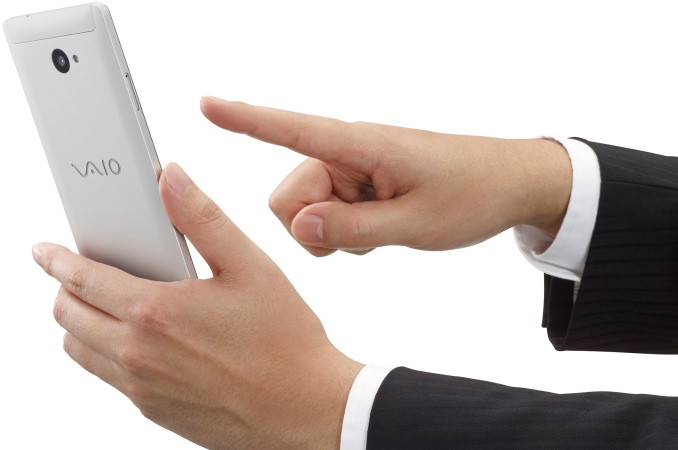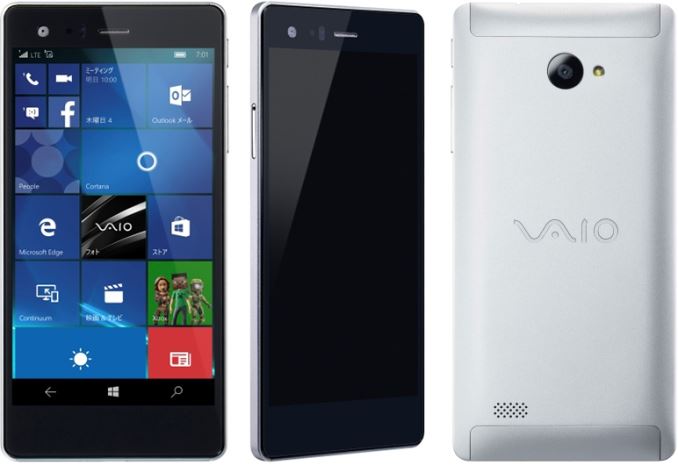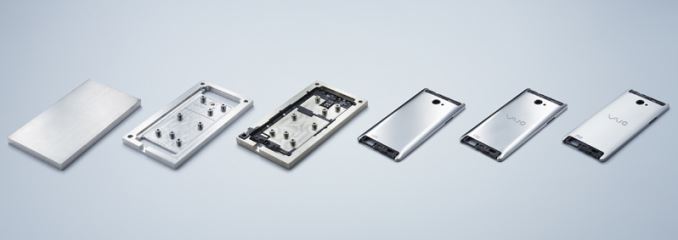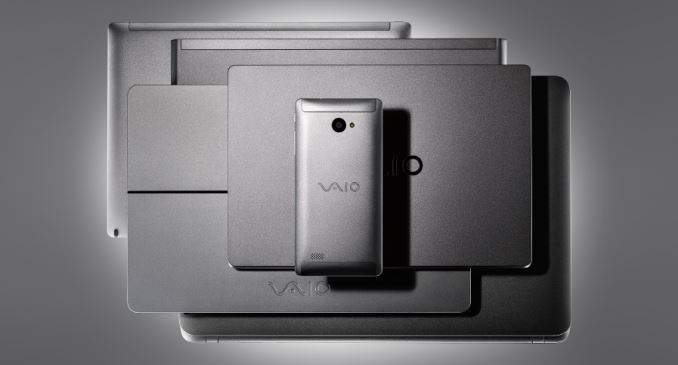VAIO to Start Selling Smartphones in Japan
by Anton Shilov on February 5, 2016 9:00 AM EST
VAIO, the former PC division of Sony and now an independent supplier of PCs, this week announced plans to introduce its first smartphone in Japan this spring. The company will use Microsoft Windows 10 Mobile operating system and will target business users with its VAIO Phone Biz handsets. VAIO intends to capitalize on Microsoft’s eco-system in order to offer products that will not directly compete against smartphones running Apple iOS or Google Android.
VAIO will promote its smartphones together with Microsoft and local operators in Japan. One of the selling points of the VAIO Phone Biz will be its support for the Continuum technology, which lets users to connect their smartphones to large displays or televisions using Miracast technology, HDMI/DisplayPort outputs, USB type-C ports or special accessories in order to use their phones like PCs (e.g., create/edit Office docs, send email, browse Internet, etc.). Since the VAIO Phone Biz smartphones will run Windows 10 Mobile, they will be fully compatible with Office 365, OneDrive, Azure Active Directory, Intune mobile app manager as well as Skype for business out-of-box. Microsoft will also help VAIO to promote its smartphones, just like it helps to sell notebooks and tablets designed by the company.
With its handsets, VAIO intends to address business users, the target audience of its PCs. Such positioning will, perhaps, help VAIO to avoid direct competition with Sony, Samsung and other companies selling Google Android-based handsets to the masses. However, since Microsoft considers itself a cloud company, it wants its apps and services to work on all mobile platforms, even a close collaboration between VAIO and Microsoft will hardly create a lot of unique advantages for the hardware company.
The VAIO VPB 051 smartphone will feature a 5.5-inch display with 1920x1080 resolution. The handset will be based on the Qualcomm Snapdragon 617 system-on-chip (eight ARM Cortex-A53 cores clocked at 1.50 GHz, Adreno 405 graphics core) and will be equipped with 3 GB of LPDDR3 RAM, 16 GB of NAND flash storage as well as a microSD card slot. The handset from VAIO will also feature 13 MP rear and 5 MP front cameras, 802.11a/b/g/n/ac Wi-Fi, Bluetooth 4.0, a micro USB 2.0 connector, various sensors, a 2800 mAh battery and so on. The smartphone is compatible with 3G/LTE bands 1, 3, 6, 8, 11, 19 and 21 with carrier aggregation (so, this particular model is not suitable for the U.S.). The smartphone will be 8.3 mm thick and will weigh 167 grams.
The VAIO Phone Biz model 051 will use a unibody carved out of solid aluminum (VAIO does not reveal exact type of alloy), which means that it should be rigid. Keeping in mind that many premium smartphones nowadays are made of polycarbonate, aluminum body could become a tangible advantage of the VAIO smartphone.
The smartphone will be manufactured by a contract manufacturer, its quality will be checked and tested at the Nagano Technology Site (Azumino City, Nagano Prefecture), the former hub of Sony’s PC operations, where VAIO already performs final checks and assembly of its PCs.
The VAIO VPB 051 will hit the Japanese market this April at the price of ¥50,000 ($428). The smartphone will not be sold with contracts, the owners will be able to choose their operator. For this reason, the handset’s bundle will include an adapter for nanoSIM cards.
The addition of a smartphone into the VAIO lineup is a clear sign that the company is planning to expand and address new markets. Moreover, with tablets, notebooks and smartphones in the family, the VAIO product line will be one of the most comprehensive Windows product lines in the world. The example of Apple shows that a vertically-integrated product stack helps to sell more products to loyal customers.
What remains to be seen is when VAIO plans to bring its smartphones to the U.S. The first-gen model is not suitable for the U.S. because of LTE compatibility issues (in fact, a business phone that cannot really support LTE in the U.S. is a strange business phone), if VAIO wants to sell it in North America, it will have to redesign its LTE module.
Source: PC Watch















16 Comments
View All Comments
xthetenth - Friday, February 5, 2016 - link
I hope it does well, any good news for WM10 is good news for me, and I think Japan's a reasonably likely place for it to have a shot, since it seems somewhat insulated from greater hardware trends.Wolfpup - Friday, February 5, 2016 - link
Yeah. I'd expect they'd be quality phones. I'm certainty intrigued by them, and by Windows 10 mobile in general. I'm still not clear on how close to being real Windows it is...like whether it's as Windows-y as Windows 8.1 RT is or not.And yes, I'd still love an x86 Windows Phone with real Windows most of all...
WorldWithoutMadness - Friday, February 5, 2016 - link
IMHO, not the right time, the platform is still immature and not to forget that MS also release their own phone. This is more or less a suicidal mission.zodiacfml - Saturday, February 6, 2016 - link
I agree. Until now, with the availability of efficient x86 chips from Intel, I still haven't seen native W10 on a phone or phablet form factor.nikon133 - Monday, February 8, 2016 - link
It is Japan, though.Considering how poor MS consoles are doing in Japan regardless their success elsewhere (I'm talking more of X360 than X1)... I'm under impression that Japanese Windows phone is likely to take majority of Windows phone share in Japan, regardless how big or small that market share is. Especially that there is no other Japanese Windows phone available, to my knowledge.
Another thing... this, indeed, might be a solid moment to get into Win phones (presuming that company is interested in WP platform in general). Two new MS phones are OK, but from what I can see, hardware wise, they are last legacy from Nokia... and while OK, they are not really differentiating much (if at all) from other high-end devices, hardware and features wise. But with Surface team taking over phones development, I think next high-end refresh will be more distinctive with original features, if Panoz and his team's previous work on Surface Pro and Book are anything to judge after... so this quiet time in WP ecosystem could be best time to get into it and secure some beachhead.
But I agree otherwise, platform is immature. It looks like W10 for phones is released with more bugs and glitches than W10 desktop, and some of its most intriguing concepts - like universal apps - are still hardly more than a concept. It almost feels like this generation of Lumia is just a development platform for polishing and perfecting W10, universal apps, continuum... before Surface phone(s) try their luck.
Flunk - Friday, February 5, 2016 - link
This is going to confuse a few people, VAIO has meant Sony for a long time. Looks like a real high-end product though so it might sell pretty well in Japan. Don't expect to see this in the USA.Guzzista - Friday, February 5, 2016 - link
This is a very astute move, as the VAIO phone will integrate seamlessly into MSFT's strategy of one OS that operates across multiple devices. I am surprised that the author of the article did not touch on this point. No other tech company has attempted this - Apple OSX and iOS are not very similar, nor are Android and Chrome. By getting in at the beginning of this evolution, VAIO should be able to sell a lot of handsets to businesses that have Windows10 installed.name99 - Friday, February 5, 2016 - link
And in this theory of yours, how exactly does VAIO achieve what Lumia did not?If the world were desperate for Windows 10 and its phone, why didn't they leap onto Lumia?
Demiurge - Friday, February 5, 2016 - link
You wouldn't want all of your devices (PC, phone, tablet, etc.) to match and work together seemlessly? Oh, wait, that's what Apple tries to do... and hey, Apple also has brand recognition... I wonder what strategy could VAIO be trying to execute?Sarcasm aside... Nokia did not sell other the other devices, which at the end, you just had a Windows 10 phone and no real connection to your other devices. It would be akin to buying a Mac and then an Android phone -- you could do it, and there are reasons to, but tempting to have that interoperability out of the box. Think Apple... only with useful applications for business and professional use.
Murloc - Saturday, February 6, 2016 - link
you already have all that connection with windows phone 10 and windows 10.Having the same hardware brand doesn't change much at all if the software is the same.
Maybe they'll be able to sell multiple devices of the same brand and that's a strategy, but it won't help WP10 particularly.